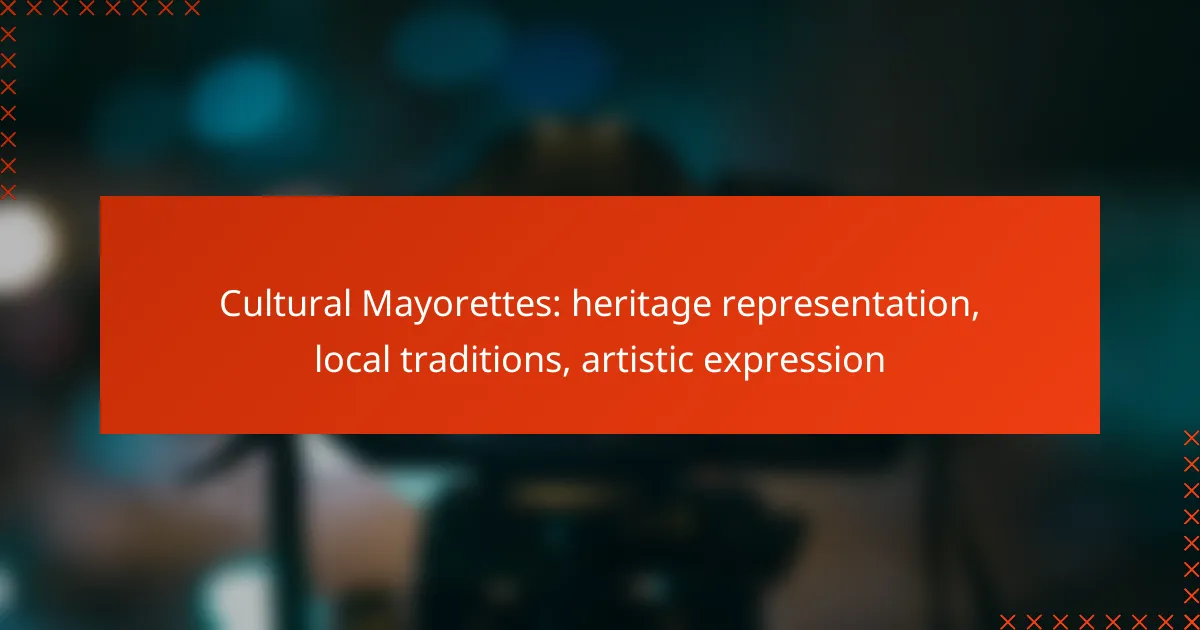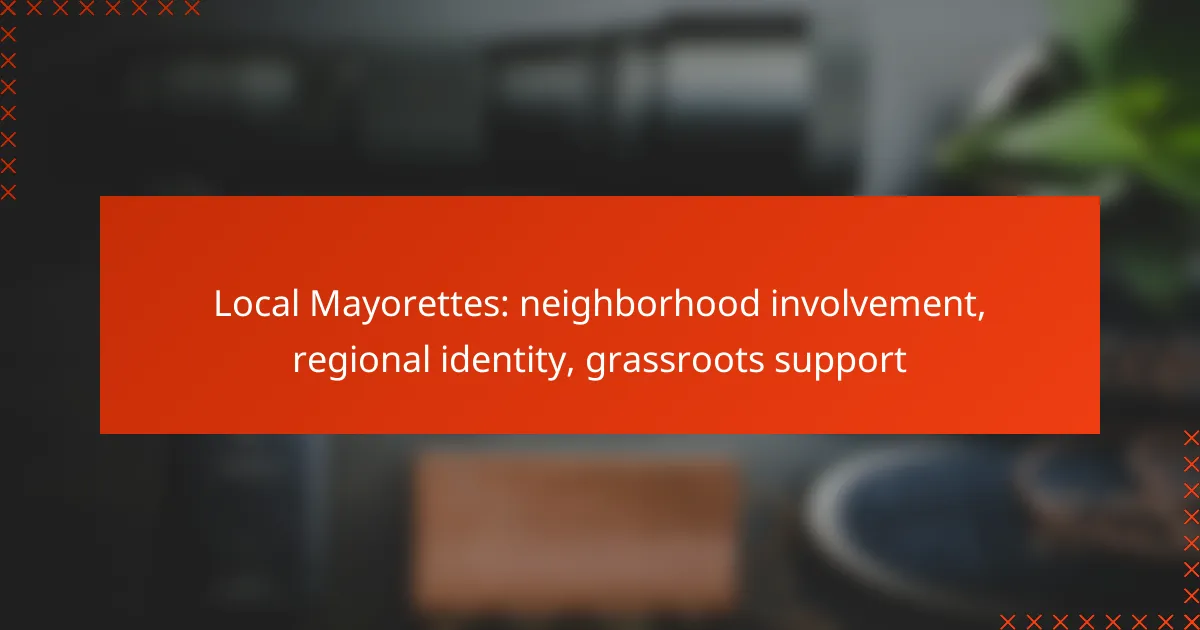Cultural Mayorettes in Canada play a crucial role in preserving and showcasing local heritage through vibrant traditions and artistic expressions. By participating in festivals and community events, they highlight regional customs and foster a deep sense of belonging and pride among participants. Their involvement not only celebrates cultural identity but also serves as a vital link between communities and their historical narratives.
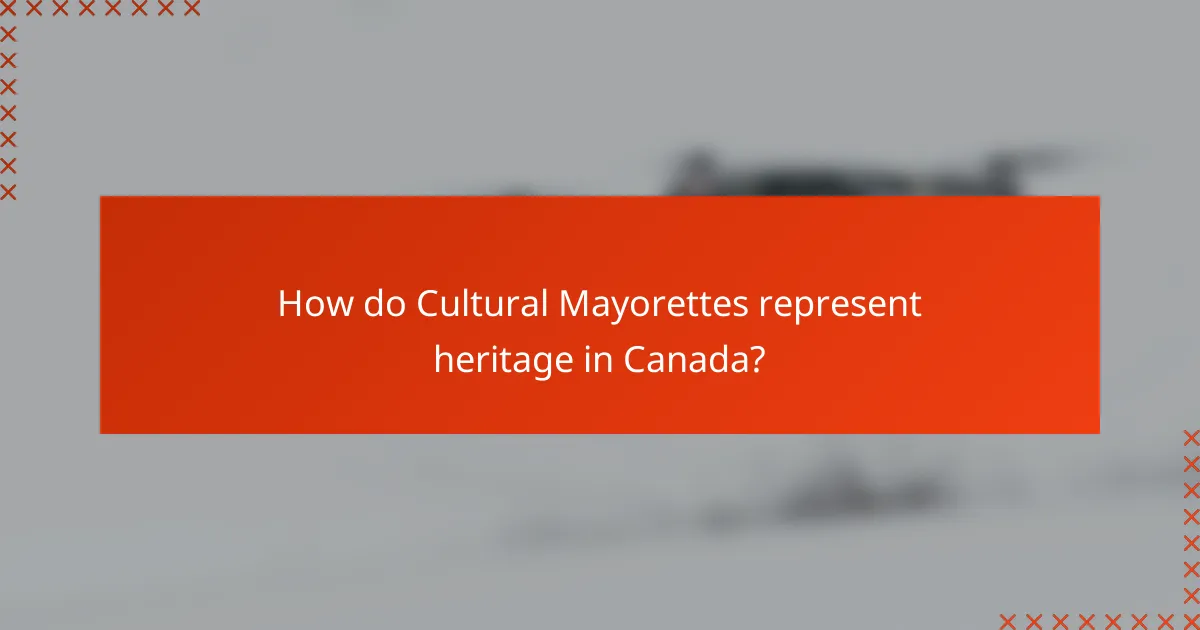
How do Cultural Mayorettes represent heritage in Canada?
Cultural Mayorettes in Canada embody heritage by showcasing local traditions, preserving indigenous practices, and highlighting regional customs. They serve as vital links between communities and their historical narratives, often participating in festivals and events that celebrate cultural identity.
Showcasing local history
Cultural Mayorettes play a crucial role in showcasing local history through performances, parades, and community events. They often wear traditional attire that reflects historical significance, allowing attendees to connect with the past visually and emotionally.
For instance, during local festivals, Mayorettes may reenact historical events or share stories that highlight significant figures or milestones in their community’s development. This engagement fosters a deeper understanding of local heritage among residents and visitors alike.
Preserving indigenous traditions
Indigenous traditions are preserved by Cultural Mayorettes who incorporate native customs into their activities. They often collaborate with indigenous communities to ensure authentic representation and respect for cultural practices.
Examples include participating in powwows, where Mayorettes may perform traditional dances or wear regalia that honors their heritage. This not only educates the public but also strengthens ties between indigenous and non-indigenous populations.
Highlighting regional customs
Cultural Mayorettes highlight regional customs by celebrating unique local practices and festivals that reflect the diversity of Canadian culture. They often serve as ambassadors for their regions, promoting local arts, crafts, and culinary traditions.
For example, in Quebec, Mayorettes might participate in the Carnival de Québec, showcasing traditional winter activities and local delicacies. This representation helps preserve and promote regional identity, encouraging community pride and participation.
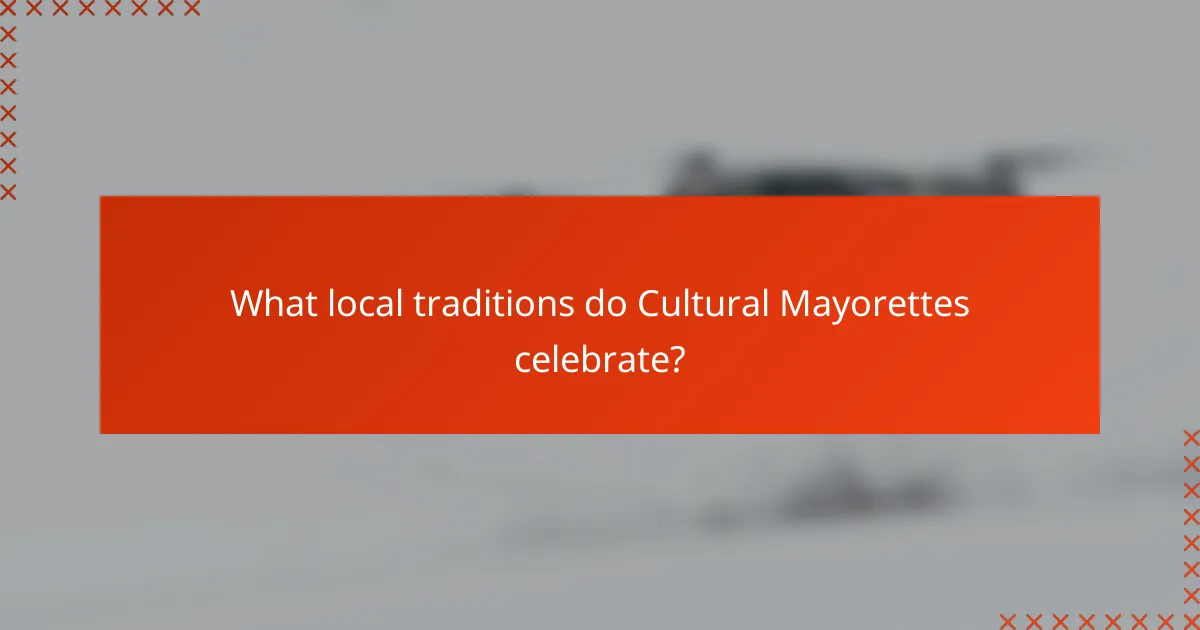
What local traditions do Cultural Mayorettes celebrate?
Cultural Mayorettes celebrate a variety of local traditions that highlight community heritage, artistic expression, and cultural identity. These traditions often include vibrant festivals, unique attire, and significant community rituals that foster a sense of belonging and pride among participants.
Festivals and parades
Festivals and parades are central to the celebrations led by Cultural Mayorettes, showcasing local customs through lively performances and colorful displays. Events often feature traditional music, dance, and food, attracting both locals and tourists. For example, many regions host annual festivals that can draw thousands of attendees, creating a festive atmosphere that honors local history.
During these events, Cultural Mayorettes often play a key role, leading processions and participating in various performances that reflect the community’s heritage. These parades can vary in scale, from small local gatherings to large city-wide celebrations.
Traditional attire
Traditional attire worn by Cultural Mayorettes is a vital aspect of their representation, often reflecting the history and values of the community. Outfits may include handcrafted garments featuring local fabrics, intricate embroidery, and symbolic colors that represent specific cultural narratives. For instance, in some regions, Mayorettes might wear dresses adorned with patterns that tell stories of their ancestors.
Choosing the right attire is essential, as it not only signifies cultural pride but also helps to preserve local craftsmanship. Communities often encourage the use of traditional clothing during festivals to maintain these important cultural connections.
Community rituals
Community rituals led by Cultural Mayorettes serve to strengthen social bonds and reinforce cultural identity. These rituals can include rites of passage, seasonal celebrations, or ceremonies honoring local deities and ancestors. Each ritual typically involves specific customs, such as prayers, offerings, or dances that are unique to the community.
Participation in these rituals is often open to all community members, fostering inclusivity and collective memory. Engaging in these practices helps to transmit cultural knowledge to younger generations, ensuring that traditions continue to thrive over time.
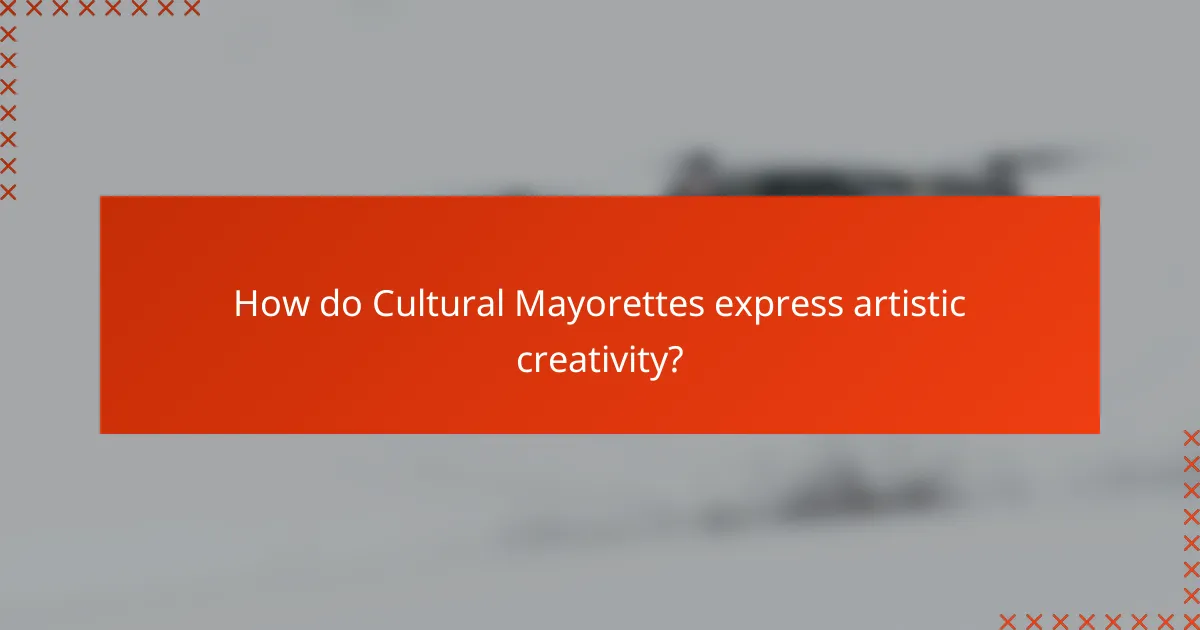
How do Cultural Mayorettes express artistic creativity?
Cultural Mayorettes express artistic creativity through various forms of art that reflect local heritage and traditions. These expressions often involve community participation and showcase the unique identity of the region.
Performing arts
Performing arts play a vital role in the expression of cultural heritage among Mayorettes. Activities such as traditional theater, folk dances, and storytelling are common, often performed during local festivals and events. These performances not only entertain but also educate audiences about historical narratives and cultural values.
In many regions, Mayorettes collaborate with local artists to create performances that highlight specific traditions. This can include reenactments of historical events or the portrayal of local legends, fostering a sense of pride and continuity within the community.
Visual arts and crafts
Visual arts and crafts are essential for Cultural Mayorettes, showcasing local artistry through mediums like painting, sculpture, and textile design. These artworks often incorporate traditional motifs and techniques passed down through generations, making them a significant part of cultural representation.
Craft fairs and exhibitions are common venues where Mayorettes display their creations, allowing them to connect with the community and promote local artisans. Engaging in workshops can also help preserve these art forms and encourage younger generations to participate.
Music and dance
Music and dance are integral to the artistic expression of Cultural Mayorettes, often serving as a means of storytelling and cultural transmission. Traditional music, played with local instruments, accompanies dances that reflect the rhythms and movements of the region.
Festivals frequently feature performances that blend music and dance, creating a vibrant atmosphere that celebrates local customs. Mayorettes often collaborate with musicians and dancers to develop new interpretations of traditional pieces, ensuring that these art forms remain dynamic and relevant.

What criteria should be considered for selecting a Cultural Mayorette?
Selecting a Cultural Mayorette involves evaluating several key criteria that reflect the individual’s connection to local heritage and community. The ideal candidate should embody community involvement, artistic talent, and a deep understanding of local history.
Community involvement
A Cultural Mayorette should actively participate in local events and initiatives, demonstrating a commitment to the community. This involvement can include volunteering for cultural festivals, engaging with local organizations, or leading community projects.
Potential candidates can be assessed based on their previous contributions to community activities. For instance, those who have organized events or participated in local governance may stand out as strong contenders.
Artistic talent
Artistic talent is crucial for a Cultural Mayorette, as it allows her to express and promote local culture through various art forms. This could include skills in dance, music, visual arts, or traditional crafts that resonate with the community’s heritage.
When evaluating artistic talent, consider the candidate’s portfolio or past performances. Engaging in local art exhibitions or cultural showcases can serve as a testament to their abilities and commitment to artistic expression.
Knowledge of local history
A strong understanding of local history is essential for a Cultural Mayorette, as it enables her to educate others and foster appreciation for cultural heritage. This knowledge should encompass significant historical events, local legends, and traditional practices that shape the community’s identity.
Assessing a candidate’s knowledge can involve interviews or quizzes about local history. Candidates who have participated in historical research or educational programs may demonstrate a deeper connection to the community’s past.

How do Cultural Mayorettes impact local tourism?
Cultural Mayorettes significantly enhance local tourism by showcasing regional heritage and traditions, attracting visitors eager to experience authentic cultural expressions. Their presence at festivals and events creates a vibrant atmosphere that encourages tourism growth and community engagement.
Attracting visitors
Cultural Mayorettes draw tourists by embodying local customs and traditions, often participating in parades and festivals that highlight regional uniqueness. For instance, a Mayorette dressed in traditional attire can captivate visitors, prompting them to explore the area further.
Events featuring Cultural Mayorettes can lead to increased foot traffic in local businesses, as tourists are likely to shop and dine in the vicinity. This symbiotic relationship between cultural representation and economic activity is vital for sustaining local tourism.
Promoting cultural events
Cultural Mayorettes play a crucial role in promoting local events, such as fairs, markets, and celebrations, which can attract both locals and tourists. Their involvement often includes performing traditional dances or music, which enhances the overall experience for attendees.
By collaborating with local organizations, Mayorettes help to publicize events through social media and community networks. This outreach can lead to higher attendance rates and greater awareness of the region’s cultural offerings.
Enhancing community identity
The presence of Cultural Mayorettes strengthens community identity by fostering pride in local heritage. They serve as ambassadors of tradition, helping to educate both residents and visitors about the significance of local customs and practices.
Through their participation in cultural activities, Mayorettes encourage community involvement, creating a sense of belonging among residents. This enhanced community identity not only attracts tourists but also promotes a sustainable tourism model that benefits everyone involved.
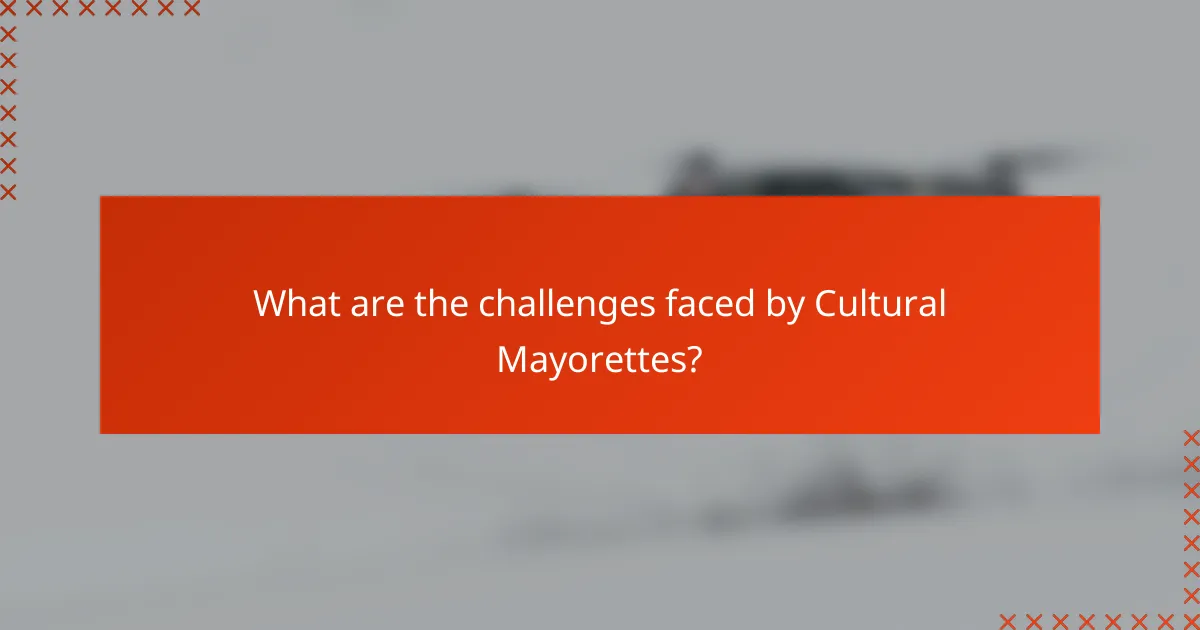
What are the challenges faced by Cultural Mayorettes?
Cultural Mayorettes encounter various challenges that can hinder their effectiveness in representing heritage, local traditions, and artistic expression. Key issues include securing funding, maintaining relevance in changing cultural landscapes, and engaging the community effectively.
Funding and sponsorship
Securing adequate funding and sponsorship is a significant challenge for Cultural Mayorettes. Many rely on local businesses, government grants, and community fundraising efforts, which can be unpredictable and insufficient. Establishing strong partnerships with sponsors can provide financial stability, but it requires ongoing relationship management and clear communication of the benefits to sponsors.
To enhance funding opportunities, Cultural Mayorettes should consider diversifying their income sources. This could include hosting events, workshops, or performances that showcase local talent and traditions, thereby attracting ticket sales and donations. Additionally, applying for grants from cultural organizations or arts councils can provide crucial financial support.
Maintaining relevance
Maintaining relevance in a rapidly evolving cultural environment is another challenge for Cultural Mayorettes. As societal values and interests shift, it is essential for these representatives to adapt their programs and presentations to resonate with contemporary audiences. This may involve integrating modern artistic expressions while honoring traditional practices.
To stay relevant, Cultural Mayorettes should actively engage with the community to understand their interests and preferences. Regular surveys, community meetings, and collaborative projects can help identify what resonates with local residents. By being responsive to these insights, they can ensure their activities remain meaningful and impactful.
